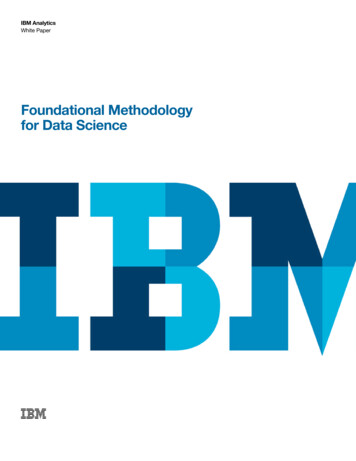
Transcription
Office of the National Data CommissionerTheFoundationalFourStarting an ongoing data improvement journey
ContentsExecutive summary. 1Introduction.3Why is public sector data important?.3The Foundational Four. 4Using this Guide.5Leadership — A senior leader is responsible and accountable fordata across the agency.6What is the role of a Senior Data Leader?.6Putting Leadership into practice — Appoint a Chief Data Officer or equivalent. 7Where can I find more information?. 7Data Strategy — An agency has a clear vision and plan for usingdata to achieve objectives. 8What is a Data Strategy?.8What is the difference between a Data Strategy and an Information Strategy?.8Putting Data Strategy into practice – Develop and implement a Data Strategy.9Contents. 10Endorsement and implementation. 13Implementation. 13Where can I find more information?. 14Governance — Mechanisms exist to oversee data management.15What is Data Governance?. 15What is the relationship between Data Governance and Data Management?. 15Putting Governance into practice – Develop a Data Governance Program. 16How is a Data Governance Program established?. 16Where can I find more information?. 19Asset Discovery — Data assets have been identified and recorded. 20Why identify data assets?. 20What is the difference between a data inventory, register, catalogue and repository?. 21Putting Asset into practice – Establish a discoverable Data Inventory . 21What makes a data inventory effective?. 21Next steps: from inventory to catalogue. 24Where can I get more information?. 24Next Steps. 25Office of the National Data Commissioneri
Copyright Statement PM&CThe Foundational Four Commonwealth of Australia 2020ISBN 978-1-925364-22-4 The Foundational Four (online)Copyright NoticeWith the exception of the Commonwealth Coat of Arms, this work is licensed under aCreative Commons Attribution 4.0 International licence (CC BY 4.0)( https://creativecommons.org/licenses/by/4.0/ ).Third party copyrightWherever a third party holds copyright in this material, the copyright remains withthat party. Their permission may be required to use the material. Please contactthem directly.AttributionThis publication should be attributed as follows: Commonwealth of Australia, Department of the Prime Minister and Cabinet,The Foundational Four.Use of the Coat of ArmsThe terms under which the Coat of Arms can be used are detailed on thefollowing website:https://pmc.gov.au/ccaOther usesEnquiries regarding this document are welcome at:www.datacommissioner.gov.au/form/contact
The Foundational FourExecutivesummaryGovernment data is valuable, but it needs to be managedeffectively to realise its value. While some agencies aremore advanced in their management and use of data,others are still developing their capability.Improving data capability can be a daunting task, witha range of risks and costs to consider. Without simpleadvice, it can be difficult knowing where to begin.Better data management is not an end in itself, but isneeded to meet the government’s policy and servicedelivery ambitions. These goals have been articulatedin a number of policy statements and reports, including: The Foundational Four are: Leadership: A senior leader is responsible andaccountable for data across the agency Strategy: An agency has a clear vision and planfor using data to achieve objectives Governance: Mechanisms exist to overseedata management Asset Discovery: Data assets have beenidentified and recordedThe APS has been investing in strengthening its dataThe Productivity Commission’s Data Availabilityleadership strategies to better use and manage data.and Use InquiryAgencies with more mature practices recommend The Public Data Policy Statement The Data Availability and Transparency legislation The Digital Continuity 2020 Policy The Open Government National Action Plan Delivering for Australians. A world-classAustralian Public Service: The Government’s APSreform agendaThese reviews and policy statements all recognise thatthe APS needs to shift its culture and build data capability.Culture is an outcome of organisational settings,behaviours and activities. Each of the Foundational Fourhave an important role in improving data capability andthrough that, shifting culture. Though it will require acontribution from APS-level staff, champions for changeare needed at the Senior Executive Level together withthat priority be given to investing in data governance.If effective data governance mechanisms are not place,the remaining elements of the Foundational Four willhave little or no impact.How well the interests of all Australians are servedthrough delivery of government programs and policy,easy to access services, and an innovative and strongresearch and development sector, is ultimately dependanton the public service meeting the challenge of effectivelymanaging data.We ask agencies to test themselves against theFoundational Four. For those who have some or allof the elements in place, it is a good opportunity toreflect on how effective they are and whether there areopportunities for improvement. If you don’t have all ofthe elements in place, then action is needed.leadership from more experienced APS agencies.Office of the National Data Commissioner1
The Foundational Four2Office of the National Data Commissioner
The Foundational FourIntroductionWhy is public sector dataimportant?Government decisions must be based on the bestGovernment agencies are custodians of a great deal ofcustodians of data manage it well so it can help deliverdata that reflects life in Australia: from people to animals,the best outcomes for Australia. It will also help buildplants and fungi; from schools to businesses to hospitals;public confidence and trust in government’s ability tofrom weather patterns to Australia’s location onhold, handle and use data, as well as meeting communityplanet Earth.expectations that data assets are managed professionally,Data held by government agencies is important. It shapesthe lives of Australians through: enabling everyday business and serviceevidence available and good quality data is critical to goodquality evidence. It is important agencies that are thesecurely and effectively.To help achieve this, the Office of the National DataCommissioner has developed the Foundational Four.operations of agencies shaping policy and program development assisting policy and program evaluation improving service delivery delivering insight to Australian people, businesses,environments and culture facilitating research and development, and providing transparency of government activitiesOffice of the National Data Commissioner3
The Foundational FourThe Foundational FourMost agencies are aware of the importance of data,The Foundational Four provides a clear starting pointand many are already taking steps to improve their dataand some simple, useful steps to take towards managingpractices. What can be difficult is knowing where to start,data more effectively. They have been chosen based onparticularly if there are multiple issues within an agencytheir importance as foundational first steps, so that futurethat need addressing.initiatives can build upon them. The Foundational Fourcomplement existing advice and experience from acrossthe Australian Public Service and draw on internationalbest practice approaches.Figure 1 - The ‘Foundational Four’LeadershipStrategyA senior leader is responsibleand accountable for data acrossthe agencyAn agency has a clear visionand plan for using data toachieve objectivesFoundational Four4GovernanceAsset DiscoveryMechanisms exist to overseedata managementData assets have beenidentified and recordedOffice of the National Data Commissioner
Using this GuideCultural change is an ongoing journey and theThe aim of the Foundational Four is, primarily, to providefoundations for agencies to start moving in the rightagencies who are beginning their data journey with adirection. Once the Foundational Four are implementedstarting place to improve their data practice. They can alsoagencies can continue to improve their data culture andbe used as a reminder for agencies looking to refresh theircapability through other activities.Foundational Four are not an end point. They are thepractices. For agencies that have already implementedthe Foundational Four, these guidelines can serve as apositive reminder of progress.It is important that agencies adapt the practices describedin this guide to their own context, culture and business/policy drivers. There is no one-size-fits-all approach to theFoundational Four and there is no set order in which youneed to implement the Foundational Four.Office of the National Data Commissioner5
The Foundational FourLeadershipA senior leader is responsibleand accountable for dataacross the agencyWhat is the role of a Senior DataLeader? as data literacy, data quality, data architecture,business intelligence, data security andA Senior Data Leader is a business role responsible andaccountable for enhancing the strategic value of anagency’s data assets. If data is managed successfully asan asset and its use is maximised, agencies can achievedata protection drive data culture change build positive relationships with otheragency leaderstheir vision and deliver their functions more efficientlyand effectively. In most agencies, this role shouldideally be assigned to a member of the SeniorExecutive Service (SES).oversee and coordinate data functions such support and promote staff who work with andmanage dataThe Senior Data Leader also plays a role in improvingOne of the key responsibilities (and challenges) of acommunity trust in the government’s handling of publicSenior Data Leader is to be able to identify, measure andsector data. The Senior Data Leader should ensurecommunicate the tangible business outcomes that haveappropriate safeguards to protect data are in place,been achieved through changes in an agency’s use andas well as improving transparency of the agency’s datamanagement of its data. Evidence of the impact of dataactivities. A Senior Data Leader may need to consideris important to create a culture that understands andagency data activities not simply in terms of ‘what canvalues data.we do?’ (e.g. from a legal or IT systems perspective),The Senior Data Leader will: lead, and be accountable for, the development andimplementation of the agency Data Strategy but also ‘what should we do?’ (e.g. from an ethical orcommunity expectations perspective).Having a designated Senior Data Leader does notdecrease the importance of the roles that other staff playset the standards and approach to datawithin an agency. Leadership for data change can comemanagementfrom all levels, all business areas and within all projects.improve data governanceA designated Senior Data Leader provides a central pointof leadership to coordinate and focus data initiatives anddecision-making.6Office of the National Data Commissioner
Putting Leadership into practice– Appoint a Chief Data Officer(CDO) or equivalentIdeally, all agencies with significant data holdings will haveThe CIO and CDO should work collaboratively as data relieson technology and a great deal of data is associated withtechnology. Together these two roles can resolve a varietyof data-related issues, bringing the perspectives of theirexpertise to the solution.a Senior Data Leader as a separate role (i.e. a designatedChief Data Officer). However, creating a new specialistrole is not always possible. The functions of the role areof greater importance than the title or where the positionWhere can I find moreinformation?sits in an organisation, and a CDO role could be assignedBelow are a few resources about CDOs in particular andto the senior executive responsible for one or more relatedthe important role they play in modern organisations:functions such as:Chief Data Officer in Government: A CDO Playbook information services(Deloitte) data analyticsA Month in the Life of a Chief Data Officer (Dataversity) digital strategyWhat is a Chief Data Officer? (Dataversity) data management Privacy Champion and/or Privacy Officer(Australian Government Agencies Privacy Code) Chief Information Governance Officer(Digital Continuity 2020)The Chief Data Officer Rises (TDAN)What is a Chief Data Officer (CIO)The Chief Data Officer Playbook (IBM)Chief Information Governance Officer(National Archives of Australia)How does a Chief Information Officer differfrom a Chief Data Officer?Australian Government Agencies Privacy Code(Office of the Information Commissioner)A Chief Information Officer (CIO) holds a different role inan agency to a Chief Data Officer (CDO), though in theabsence of a specific staff member to undertake a CDOor equivalent role, a CIO can often take on some of theirresponsibilities.Traditionally, a CIO leads the IT strategy for an organisationQuestions to ask: How does a Senior Data Leader role fit withour existing governance structures? What type of Senior Data Leader role makessense for our agency?and efficient use and management of an agency’s data What will the role be called?holdings. A CDO is not a technological role and should What specific duties and responsibilities willthe role have?including IT, is important. The CDO aims to understand the How will the role be formally endorsed?strategic value of data, the safeguards required to protect How will the role collaborate with other seniorexecutives, executive and APS level staff toadvocate for better use and management ofdata?and is responsible for managing technology assets.The remit of a CIO does not traditionally includeresponsibility for data outside the IT systems. A ChiefData Officer (or equivalent) is responsible for the effectivenot be focused on the technology side of data.However, being aware of an agency’s data infrastructure,it and what is required to maximise its use. The role shouldalso guide technological decisions where the protectionand security of data are concerned.Office of the National Data Commissioner7
The Foundational FourData StrategyAn agency has a clear visionand plan for using data toachieve objectivesWhat is a Data Strategy?The scope of the Data Strategy can be expanded inA Data Strategy is a detailed plan for an agency’s datapractices mature.a second or third-phase Data Strategy as an agency’sand how it can be best used to meet the agency’s broaderbusiness objectives and priorities.technologies and innovations to get the best use out of anWhat is the difference betweena Data Strategy and anInformation Strategy?agency’s data. It identifies a target state for agency dataA Data Strategy is closely related to an Informationuse and a pathway to get there.Strategy but narrower in remit. An Information StrategyIt can provide an opportunity to refresh current practicesaround data collection and use, and to implement newA well-rounded Data Strategy should consider alldata processes, what is required at each step ofthose processes and where improvements need to bemade and efforts focused. It may also consider othermeasures, such as skills and capability building,and cultural change activities.Ideally, all agency data would be within scope of aData Strategy. However, due to resource constraints,an agency may choose to initially limit the data in scopeof the strategy. For example, an organisation may chooseto focus on its program data, but not its corporate data‘describes your agency’s planned approach to informationmanagement to meet current and future organisationalneeds and regulatory requirements’1. It includes all ofan agency’s information, including data and all filesand records.Data is just one of many different types of information anagency will hold. A Data Strategy only focuses on data andassociated practices, but the two strategies should align.Some agencies may choose to have a single InformationStrategy incorporating information and data, others maychoose to have separate but related strategies.(e.g. Human Resources gement-strategyOffice of the National Data Commissioner
Putting Data Strategy intopractice – Develop andimplement a Data StrategyThere are some key considerations when developingThe following article outlines the componentsof a number of data maturity models:Data Governance Maturity Models(Lights on Data, 2018)a Data Strategy:Value propositionBefore you embark on a Data Strategy you shouldEngagement, consultation andcommunicationunderstand the value proposition: ‘Why are weA Data Strategy aims to drive transformational changedoing this?’ and ‘What’s in it for me?’. For some areasacross an agency. Engagement and consultation will beof an agency, the need for and benefits of a Data Strategyessential to develop buy-in from staff and drive changeare obvious. However, this is not the case for everyone,through the strategy.particularly when a Data Strategy may divert resourcesfrom one stream of work to another. This is where a valueproposition can be beneficial. It will clearly articulatewhat the benefits of the Data Strategy are for all partsof the agency.A stakeholder analysis can be undertaken to determinewho will be involved and impacted by the Data Strategy,and the level of influence each stakeholder has.Other elements to consider are the frequency with whichyou engage, using a co-design approach, ensuringThe different perspectives, values, concerns and prioritiesyou engage across all staffing levels, using a variety ofof stakeholders will need to be considered to develop valueengagement channels to communicate progress, andpropositions. Spending time defining what value looks likedemonstrating you have heard the input from stafffor stakeholders and tailoring messages is important toincluding how it has shaped the strategy.gain buy-in.SizeState analysisThere is no right ‘size’ for a Data Strategy. It needs toTo inform your Data Strategy you need to have somebe as long or as short as necessary to achieve desiredunderstanding of what your agency’s data capability is;outcomes. An agency can focus on small improvements,your agency’s current state.or big transformation. The scale of the Data StrategyOnce you know your current state you can identify whatyou want your future state to look like and what pathwaywill depend on resources, culture, appetite and what isrealistically achievable for an agency.can get you there.Agencies may use a formal maturity model to conductTimeframetheir state analysis (see ‘Where can I find moreThere needs to be a balance between choosing ainformation?’ for details) or they may use sometimeframe that is too short to achieve meaningful change,other method, such as workshops or focus groups.or one that is too long to respond to the changing dataA risk analysis may inform your state analysis.landscape. Typically, an agency’s Data Strategy wouldA data audit or inventory may also help shape the DataStrategy as it allows agencies to determine the extent ofspan three years, with regular ‘check-ups’ or progressreports to assess how the Data Strategy is performing.their data holdings and how they are stored, managedand used.Office of the National Data Commissioner9
ContentsWhere an agency holds and manages personalThe contents of a Data Strategy can vary, but some usefuland alignswithDatathe PrivacyAct 1988 and the Australian PublicPolicy Statementelements to include are: Vision statement Alignment with Government data policy Alignment with internal policies / strategies Strategic objectives Initiatives/areas of focus Measurable outcomes/indicators of success RoadmapVision nformation,is important theDataStrategycompliesGovernment Agencies Privacy Code. Government response to the ProductivityCommission’s Data Availability and Use report Digital Continuity 2020 Policy Privacy Act 1988 and Australian GovernmentAgencies Privacy Code Data Sharing PrinciplesThis outlines where an agency desires to be and whatProtective Security Policy FrameworkAustralian Government InformationSecurity ManualDe-identification Decision Making FrameworkDelivering for Australians - A world-classAustralian Public Service: The Government’sAPS public reform agendathe Data Strategy should ultimately achieve. This shouldbe short, catchy and future-focused. If an agency alreadyhas a strong vision statement, it may be helpful to relatethe Data Strategy to this.Internal policies/strategiesA Data Strategy may struggle to get traction if developedin isolation. It should complement and leverage existingExamples of Data Strategy vision statementsinclude: Data is F.A.I.R (findable, accessible,interoperable, and reusable) Service delivery is enhanced throughmaximising the value of our data Data drives decision making to achieve policyoutcomes Public trust is enhanced through transparentcollection and use of dataStrategic alignment with Governmentdata policyThere are many initiatives within Government that mayhelp to shape a Data Strategy. As government agencies,it is important that any activities related to the use of datareflect the direction of current Government commitments.A Data Strategy should be compliant with mandatorygovernment legislation and policies, and align to thegreatest extent possible to non-mandatory policies.10internal strategies, policies and roadmaps, such as theCorporate Plan. This is particularly relevant in the areaof ICT. The Data Strategy should consider the technicalrequirements needed to support its implementation suchas data warehousing capability. These requirementswill need to align with your agency’s ICT or enterprisearchitecture directions.Examples of relevant internal policies include anagency’s: Mission or vision statementBusiness strategyCorporate planEnterprise Architecture strategy / roadmapICT strategyInformation Management StrategyInformation Governance FrameworkPeople / Workforce / Capability strategyPrivacy policyOffice of the National Data Commissioner
Strategic objectivesInitiatives/Areas of FocusStrategic objectives define what you want to get out ofThese are the heart of the Data Strategy. The Initiatives orthe Data Strategy. They should be supported byAreas of Focus identify what an agency is going to do asexplanatory text so it is clear to all staff members whatpart of its Data Strategy.they mean in practice. The strategic objectives shouldalign with the Vision Statement and also reflect theoutcomes of the State Analysis.There are many different areas an agency can focus on aspart of the Data Strategy. The particular areas of focuswill depend on the outcomes of the state analysis,the scale of data activities within an agency and theExamples of strategic objectives include: Build first-class analytics capability Create a data culture Manage privacy proactively using aprivacy-by-design approachManage and use data to improve clientoutcomesresources available.Examples of Initiatives/Areas of Focus include: Improving data governance Building skills and capabilities Supporting IT (infrastructure, architecture) Developing and implementing standards andmetadata Improving the culture and environment arounddata management Ensuring appropriate data securityFuture-proof data infrastructureBreak down data silosEnsure transparency in data collection,access, and useEstablishing career pathways fordata scientistsEnsuring consistent data management acrossthe data lifecycleRemediating legacy dataFacilitating data migrationImproving process management andtransformationEstablishing privacy governance to guidemanagement of personal informationEach Initiative or Area of Focus should be associated withone or more of the Strategic Objectives. If an initiativecannot be aligned to a Strategic Objective, then it is likelynot a priority.It is important to identify who within the agency isresponsible and accountable for each of the initiatives.It may be a position within a team or it may involvecollaboration between different areas. To ensureaccountability and responsibility, ownership of initiativesmust be clearly indicated so all staff know who isresponsible and accountable for each initiative and it canbe factored into business planning.Office of the National Data Commissioner11
Example 1:Measureable outcomes/Indicatorsof success2Vision Statement: Data is F.A.I.R (findable,accessible, interoperable, and reusable)A good Data Strategy should include ways to measureStrategic Objective 1: Ensure transparency in datacollection, access, and useuseful evidence for management to ensure ongoingInitiatives to meet Strategic Objective 1: Increase data management skills acrossthe data lifecycle Responsibility: Learning andDevelopment team Release data as open where appropriate Responsibility: IT, Data teams,Publishing team success or progress. These performance indicators aresupport, as well as identifying where changes or resourcesare needed.The measures should directly reflect the initiatives withinthe strategy. Measures can be qualitative or quantitative,noting that data management lends itself well toquantitative measures. Quantitative indicators are alsoeasier to measure and compare across the lifespan ofthe Data Strategy. They can also be persuasive for seniormanagement.Use data platforms to increasedata accessibilityRegular ‘check-ups’ or review points should be Responsibility: Data team, IT,Web Services teamand adjustments made if objectives are not being met.Ensure all data is catalogued to increasediscoverability and promote reuse Responsibility: Publishing team,Cataloging team, IT, Data teamsincorporated into the roadmap so progress can be trackedExternal stakeholders and data users may also beconsidered when developing success indicators.Examples:RoadmapQuantitativeExample 2:Vision Statement: Data drives decision making toachieve policy outcomesStrategic Objective: Build first class dataanalytics capabilityInitiatives: Establish career pathways for data scientists Responsibility: Learning and DevelopmentTeam, Senior Management, Supervisors 212Establish a Community of Practicefor analytics 50% of data remediated 95% data catalogued internally65% of staff completed datamanagement trainingQualitative Staff understand the value of data tothe agency Staff are confident in their ability to accessdata required for their job Agency is referred to as a ‘data leader’by stakeholders Responsibility: Data teams, AgencyData ChampionsRoadmapSponsor data ‘hack-a-thons’ involving analystsand policy officersA Roadmap is a complementary product to the Responsibility: Senior Management,Agency Data Championsand the timelines for completion. This allows an agencyData Strategy. The Roadmap details the various initiativesto ‘map out’ the flow of activities and ensure they occurThere are some established frameworks for developing measures of success that agencies can use, such as OKR (Objectives and Key Results),KPI (Key Performance Indicators) or SMART (Specific, Measureable, Achievable, Relevant, Time-bound) goals.Office of the National Data Commissioner
in a systematic order, particularly if activities are Change and improvements take time. Don’t bedependent on others. It is
and accountable for data across the agency Governance Mechanisms exist to oversee data management Strategy An agency has a clear vision and plan for using data to achieve objectives Asset Discovery Data assets have been identified and recorded Foundational Four Figure 1 - The 'Foundational Four'










